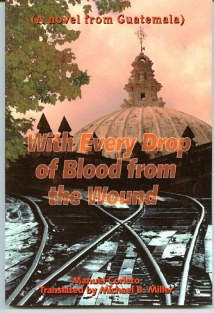Content:
With Every Drop of Blood from the Wound (Buy the book)
An Introduction by Alondra Badano
(Translated by Michael B. Miller)



Alondra Badano is Professor of Literature at the University of Panama,
actress and stage director, and a member of the panel of judges for the
1996 Rogelio Sinán Award for Central American Literature.
A Prologue
Some notes:
Confronting such an unusual work among the group of sixteen novels that competed for the 1996 Rogelio Sinán Prize for Central American literature, opportunely established by the Universidad Tecnológica de Panamá (The Technological University of Panama), was--in my view--what inclined the panel to award the prize to With Every Drop of Blood from the Wound by Guatemalan author Manuel Corleto.
It is a rare and singular work, elusive, audacious, irreverent even in its form (which becomes style), and breaks away from most traditional readers would define as a novel. It is at once a deconstructive and organic work that stands on its own. At times crude, yet tender, alienated and alienating, violent, sexual, atavistic.
It is a work set in Guatemala during the second half of this century, with an explicit reference to the festivals sponsored under the dictatorship of General Ubico (1931-44) and takes place in a neighborhood called Gerona, located near some tracks where the children play in the abandoned railroad cars. Three generations of people live there, organized into a world of relationships characterized as typical of Latin families. A work of everyday language, it emits that clamor of a continent that left its imprint on us with the sound of boots, like those of Olivia de Barahona's father [Colonel Benemérito Solís, a retired military officer] who clicked his heels and turned to leave the room, the sound of his boots against the floor of the hallway still vibrating in [her] ears.
However, the smell of guayaba [the tropics] that Corleto presents here is quite different. The text rejects an imitation of life in any sociological sense and instead leads us toward an interpretation of what we are and what were like [as Central Americans]. [Corleto's] realism presents multiple prisms in order to put an end, finally, to the [proverbial] round egg [the outer shell, the stereotype of the Latino]. The sad thing is that this round egg [as it were, this image] is being dumped on us continually, but postmodernism is at the point of breaking it and eating it fried [swallowing it whole]. In the text we read: When those eyes say nothing, when they become a mirror where we see ourselves reflected, when we can only see our own soul, [fate] turns against us.
Apparently we are neither able to look at ourselves in the mirror nor see beyond our own noses, because we already know that we seem ridiculous. And so ...
With Every Drop of Blood from the Wound is not satisfied with just speaking to us of America--of young Indian girls procreating with men from across the ocean, of Caribbean blacks with strange accents mimicked by their masters dressed in impeccable linen suits, of women abandoned by rich foreigners from the far reaches of the earth, the ocean, North America, of money, of the ghosts of pre-capitalistic Gerona, of the story of a wretched piece of railroad history. A place stuck within itself, a Gerona that operates in cycles, a Gerona of earthbound byways, violence, its men and women galloping across the land, fornicating, murdering, listening to Debussy and saying prayers in order to void in celestial orgasms: so many centuries of repression, so many disappeared, a country robbed of so much culture. The writing goes beyond that and therein lies its artistic impact.
Gerona-Macondo-America, all structured of another kind of literary material. The text appeals to the macho reader of Cortázar; it does not attempt to stir emotion, but rather to provoke the fragmented conscience towards a reaction. Characterizing the human being as the miserable and crude footprint of a stifling orphanhood, one where men and women function within the system, Corleto assumes the writing of marginalization, fashioning his oddball characters--those metaphorical figures of his--out of a rejection of all institutionalization of power. For Corleto that world does not work, that much is clear. Then why describe it? Because it is better to break open [the proverbial egg] to recognize what is horrifying and laughable, to unmask the atrophied behaviors through the deformed images of surreal beings whose vital signs approach cruelty. The subordination that governs human relations is toyed with to the breaking point, accelerating the conflict of the individual caught in either hyperbolic horror or laughter. The nightmare ends in an irony that dilutes the tensions in the text, but which offends one's sense of dignity in some scenes. What is horrible dissolves into sadness and even makes us laugh. Like a play, every scene reveals something about one or more of the characters, characters who continually find themselves entangled with each other; sometimes dissolving amidst the interweaving of the anecdotal and always remaining suspended in time. As in a painting, under the horror of emptiness, disconnected stories appear in different sequences. It looks like existential chaos even though the plot groups the characters around families; Corleto employs a fragmented technique, one where there is no attempt to follow other literary models.
At its very core, With Every Drop of Blood from the Wound is the story of the construction of a soul, a single Onettian soul [Uruguayan novelist, Juan Carlos Onetti] that moves from its embryonic state toward the possibility of becoming--so alone and so complex--a living being. In the story, the author dissects two friends to form a double image. It is no accident that these two adolescent boys--growing up together and becoming men before our eyes--meet again at a distinct stage in their lives. They are the connecting links in the random story line, something that could symbolize the struggle for personal growth in its Dionisian-Apollonian dialect. This personal crisis constructs a feeling of love and friendship, the only lasting values, the ideal towards which the novel points.
How is this thematic weave constructed? We need to look at the form and the substance of the work. The author cuts deep into his creative talent and steers it toward an introspection of his own experiences: childhood memories, episodes in his coming of age as a man, the social truthfulness of his writings, and a certain open-ended philosophical structure.
The warmth of community is the fundamental shelter where the suffering Gabriel--Corleto's alter ego--steels himself in the face of death and indifference, and the grave evils--among other things--that the people in this story suffer. The young boy defends himself against his father's choleric temperament; even though he is beaten, yet Gabriel rises from the floor each time, without a whimper, to become the target once more of his father's fists. Gabriel is continually shaping his personality in order to know love in a pure and disciplined way, a love that is sensitive, far from the emotion and the tears that represent love's exterior trappings.
The feelings are real, not feigned; the strength of this position, with its genuine sentiments, comforts the morose Gabriel, no matter how long it takes; time and space have already been surrendered to death or to other forms that represent the end: injustice, social violence, sexual violence, etc.
Willy, his best friend and his alter ego, is the aggressor, beginning with his childhood and living in the shadow of his grandfather, a retired military officer who had thrown his mother [Olivia] out years ago. Willy grows up with two capricious sisters who always need to run to the bathroom. As one who possesses an enormous penis, he is insatiable and even goes on the prowl among lascivious and unscrupulous older women. Thus, he has felt torn ever since childhood; his final fate does not surprise us: a loveless marriage, held together with credit cards.
Like a psychological treatise, dysfunction defeats intelligence, and in the end, Gabriel, who is inherently intelligent, wants to die. From that moment on, his words are concise and evasive, and the amorous dialogues allow us to glimpse the impossibility of a stable and lasting love. [What is all this?] A theory of suicide like seppuku? Shades of twentieth century existential literature? Reflections on the substrata of the fable, ambivalence about life and death?
Without any flashes of desperation or negativity or euphoria on his part, Corleto shuns the mystical or fantastic and pushes the discourse away from the edges of magical realism; instead, the material bends over backwards towards the facts themselves, a returning to what is real on a higher level. A bit of Brecht? This separation is a purifying element and this returning--worked out in its fictional form--fulfills the role of exorcist, an exorcist of phantoms that have been transformed-more than ever--into certain powers (church, state, family). The return of sin, as seen in the simple naivete of a character like Floridalma, for example, belongs to the objective magical order that--in some distant past--once conformed to the Universe, an order that might be linked to an objective approach to realism, seen with a special eye from an Oriental perspective. The telling of the story loses none of its brilliance because of any uneasiness on our part; Gerona's crudity is shown to us without emotion or tears or judgement on its social ills.
Are these new perspectives on our continent ones that appeal to a cold and serious reflection on the nostalgic or dramatic realities with which we have viewed our culture until almost the end of this century? Is this novel an effort to get us out of our emotional morass? Will we have to change our instinctive view of things? And with troubled hearts, is it possible that the time has come for drying our tears?
The crest of the wave is the moment of greatest tension and greatest calm in the sea, said the Sansei. Corleto is clear about this much and has said so. There is hope, but not an idealization of the hope one finds in philosophical treatises. Our only hope is to live with love and in the end to strip the discourse of all ideology.
Heads, torsos, legs, arms in the field of study that Guatemala has offered up for such a long time is not an abuse of the metaphor. In the narrative, Otto, the man with the dolls neatly arranged in his workshop--the monster with a German name who exercises the role of executioner--tries to implant eyes in empty holes or to amputate an arm from the doll's body and so represents the great cultural genocide that our communities and towns have suffered [over the years]. Nevertheless, this loss of manhood and womanhood is reborn in the vigorous voices of its artists who--like Osiris--continue creating the myth, for a time, of resurrection and the virgin birth.
There is one more pleasure to be considered here--the language of words of but four letters, rigorously virginal like the lotus flower that blooms white in the middle of the swamps. And a confession: the first chapter, magisterial and so greatly noted, not because of the virile hand that brandishes it before us, but for the histories it correctly tells of.
#


